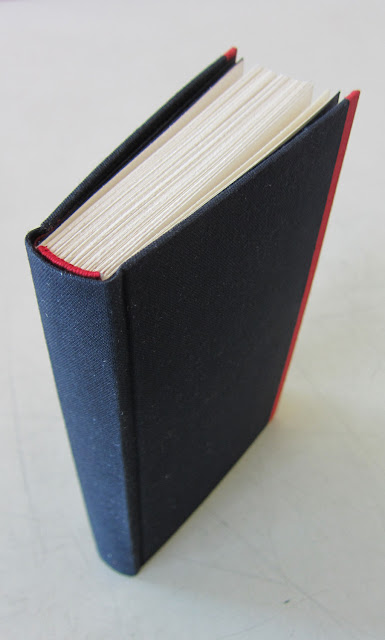This term's bookbinding course was conducted by Julie Leonard. She is an amazing instructor and I learned a lot thanks to it! We covered a lot of structures and did a few variations of each. Some of what we did has been posted here. More books to come!
Prepping the book for sewing on headbands
Beginning sewing after the core has been placed and held by the endbanding thread
This isn't the best example as the sewing was loose, but it gives you an idea of
how the endband progresses as you wrap and secure it around the core
An example of a rounded spine case binding with sewn on headbands and a fore-edge strip
The headbands were sewn using red thread to match the flange visible on the inside and the fore-egde strip
The red cloth flange peeking through from behind the paste down
I eventually gave this book to a friend of mine whose name I calligraphed on the inside in the Engraver's Script
A german lapped case binding. I made a variable edition of 5
A paste down would cause a problem in this case as the cloth flange creates a certain distance from the board which in turn will show through the past down and appear unseemly
Trying to create a slight gradation of thicknesses, easing them into the board. As you can see there is book cloth, japanese paper lining and the lapped case component
To fix this problem I did a fill to create an even layer over which to put the paste down
A detail of the fill
Rounded case binding with fore edge corners. This is also called a 3/4 cloth binding because technically as I understand it, the total amount of cloth used on the spine and the corners equals 3/4 of the total open width of the book
Detail of the headband
Long and link stitch. This non-adhesive structure was traditionally
used in Germany and Italy in the 17th century for account books
I did a basket weave over the long stitch after completing the binding
Ethiopian binding with cloth covered boards
Detail
For the flyleaves I used beautifully printed Italian decorative papers
Perfect binding
Or lets say, far-from-perfect binding. They were fun and easy to make but not very structurally sound.
For this specific book I used Nepalese Lokta paper for the cover and dyed banana paper for the flyleaves
Drumleaf binding
The folios are literally 'drummed' along their fore edges and adhered along their spine edges
A piece of book cloth is then used to create the spine piece
This structure is good for binding together work created on separate folios or
work that requires that no thread passes through the center of the piece
work that requires that no thread passes through the center of the piece
This particular book is a collection of letterpressed folios done
this past semester in our Letterpress 2 class
this past semester in our Letterpress 2 class

























No comments:
Post a Comment